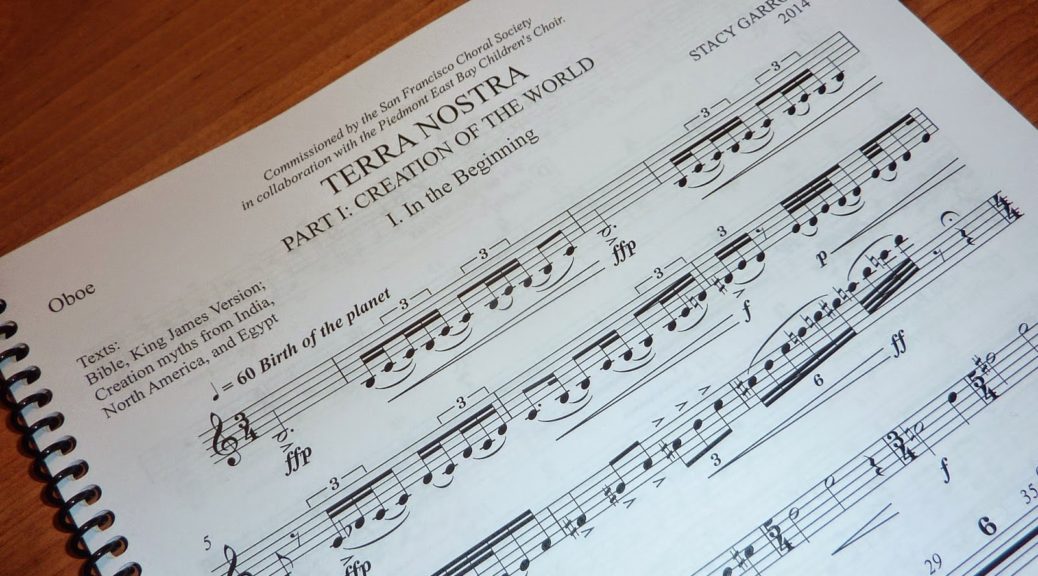
BIGGER-THAN-LIFE ORATORIO, ABOUT ALL HUMANITY
Garrop’s Eloquent World Premiere Given by Local Chorus
The choral-orchestral “Terra Nostra” given its world premiere here Nov. 14 is a colossal effort, the largest-scale oratorio introduced in these parts in decades. The eloquent work running some 80 minutes is a secular one in three parts, from the world’s early beginnings and the dawn of humanity. Had composer Stacy Garrop been content with the first two parts and stopped, I might have been jumping off bridges, given the ending lament of man’s destructiveness, environmental and otherwise. Fortunately, she concludes the piece by adding the hope of resolution and serenity, via lines out of Walt Whitman on the symbolism of grass portraying a form of salvation or consolation.
The unveiling of this “Our Land” oratorio was a multi-year project of Robert Geary and his San Francisco Choral Society, with close to 300 performers jammed into the First Unitarian Church to carry it off, spilling over the extremities of the chorus risers. It was an epic achievement as well as a thoroughly contemporary textual outpouring, representing a paean to humanity and our ability to grapple with the challenges of our times, with the preservation of our planet coming first and foremost.
Garrop, 46, is a Chicago-based composer who assembled many poetic texts for her magnum opus, ranging from Wordsworth, Byron, and Shelley to a few lines out of Genesis, the latter part linked to various creation myths assembled from varied cultures—starring not just God, but also Svayambhu (Hindu), Inkommi, Khepri (pharaonic), Shu and Fetnut.
In the last analysis, here is a strong work to play at international convocations as an alternative to the trusty perennial Choral Symphony.
Garrop’s musical style and harmony grows out of the traditional English oratorio of the early 20th century as found in scores of Howells, Britten, R.V. Williams and Walton. She creates exquisite moments, like the interwoven duet for soprano and mezzo in Hopkins’ “Binsey Poplars,” and the light-footed traverse of a Shelley poem done for large children’s chorus, bringing ethereal blessings. When the children move on to Whitman’s “Grass,” the moments are deeply touching.
Meanwhile her orchestra runs wild and disoriented in depicting the creation, with bursts of uncouth brass and timpani leading into a restless march. A tamtam proclaims the almighty. There is also a noisy intrusion of early humanity, and a dirge, and the mysterious pairing of high piccolo with sub-basement cello. Only when drought and global warming take the stage does the sound turn melodramatic.
The baffling nonsequitur in the piece comes at the midpoint with a poetic ad for a brand of luxury automobile—totally uncalled for (but hey, maybe they were project underwriters!).
Performing it all with spirit was the 125-voice SFCS mixed chorus, an admirable 100-voice Piedmont Choir, four soloists and a chamber orchestra. All was under the baton of the indefatigable Geary, who held the stirring performance together with his multiple cues. Given the overly resonant church, the sound was at times deafening. Still, it added up to an amazing poetic trip through world history, with seatbelts securely fastened.
As for Morten Lauridsen’s popular half-hour-long “Lux Aeterna” packed into the same SFCS concert of generous length—sorry, M.L., we’ll have to leave that for another day. No more space!
Garrop’s “Terra Nostra” oratorio world premiere, unveiled Nov. 14-15 by Robert Geary and his San Francisco Choral Society, First Unitarian Church, S.F. For SFCS info: (415) 221-5590, or go online.
©Paul Hertelendy 2015
#
Paul Hertelendy has been covering the dance and modern-music scene in the San Francisco Bay Area with relish — and a certain amount of salsa — for years.
These critiques appearing weekly (or sometimes semi-weekly, but never weakly) will focus on dance and new musical creativity in performance, with forays into books (by authors of the region), theater and recordings by local artists as well.
#